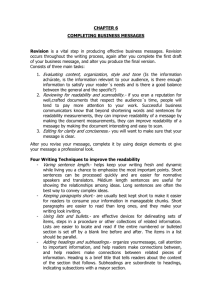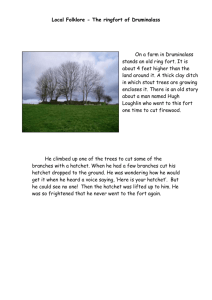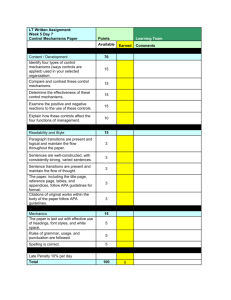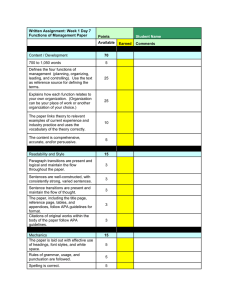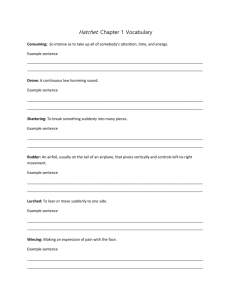Document 13133108
advertisement
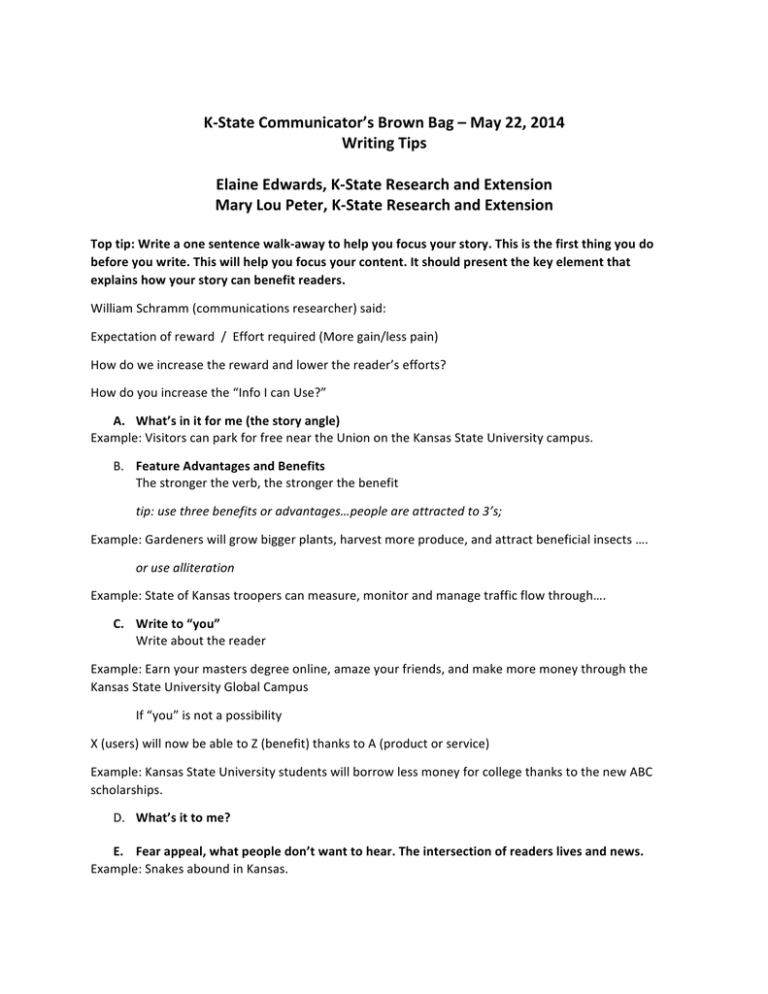
K-­‐State Communicator’s Brown Bag – May 22, 2014 Writing Tips Elaine Edwards, K-­‐State Research and Extension Mary Lou Peter, K-­‐State Research and Extension Top tip: Write a one sentence walk-­‐away to help you focus your story. This is the first thing you do before you write. This will help you focus your content. It should present the key element that explains how your story can benefit readers. William Schramm (communications researcher) said: Expectation of reward / Effort required (More gain/less pain) How do we increase the reward and lower the reader’s efforts? How do you increase the “Info I can Use?” A. What’s in it for me (the story angle) Example: Visitors can park for free near the Union on the Kansas State University campus. B. Feature Advantages and Benefits The stronger the verb, the stronger the benefit tip: use three benefits or advantages…people are attracted to 3’s; Example: Gardeners will grow bigger plants, harvest more produce, and attract beneficial insects …. or use alliteration Example: State of Kansas troopers can measure, monitor and manage traffic flow through…. C. Write to “you” Write about the reader Example: Earn your masters degree online, amaze your friends, and make more money through the Kansas State University Global Campus If “you” is not a possibility X (users) will now be able to Z (benefit) thanks to A (product or service) Example: Kansas State University students will borrow less money for college thanks to the new ABC scholarships. D. What’s it to me? E. Fear appeal, what people don’t want to hear. The intersection of readers lives and news. Example: Snakes abound in Kansas. Essay vs. pyramid style writing Classic essay formula: Use for most news other than urgent (than use pyramid) Lead (gets reader to keep reading, show reader than tell; get their attention) 25 words or less Nut (put story into a nutshell, the shiny object, where are we going, what’s in it for you. Make a promise, key message, abstract idea Background info…. #1 subhead #2 subhead #3 subhead Wrap-­‐up (nut paragraph…what we told you) Kicker (same technique as lead, leaves a lasting impression. Make your writing easy to read Write to word counts (200 words/minute) Shorten: think packages (use sidebars) 42: Average words in paragraph; nothing more than 1 ½ times (63 words per paragraph) 14: Average words in sentences (for 90 % comprehension). Use 8 words per sentence for 100% comprehension. Use readability statistics. What level is your writing? Turn it on in MS Word. Use short words (aim for 2 syllables) Aim for 0% passive sentences Active: subject verb object: man bites dog Passive: Dog is bitten by man. (Longer, weakens verb) • • Origin of the inverted pyramid: Dates to the Civil War when telegraphs were the first communication tools used that did not physically involve a message being delivered from one person to another. Messages had to be short, so you had to get the most important information in at the beginning. Sooooo…. We’re using a tool built for technology that’s no longer used. Headlines (shoot for eight words or less). • Lead: Try writing leads that use human interest; wordplay; description; metaphors; anecdote; juicy details; startling statistics; or compelling benefits. Try to keep it to a maximum of 25 words. Example of a description lead: “In a Capitol room thick with the smell of fast food and breakfast entrees, proponents of Senate Bill 120, the proposed nutrition menu labeling law, dramatically illustrated why this legislation needs to be signed by the Governor.” • Example of startling statistics: “Every day, each of the 25,000 U.S. veterinary clinics will get on average, a visit from two arthritic dogs. Odds are, one of those dogs will leave the clinic untreated, still suffering in silent pain. “More than 10 million dogs (that’s one in five adult dogs) suffer from osteoarthritis..” • • • • • Make it Meaningful with Metaphors: Help your subject matter expert develop an analogy. Ask, “If you were explaining this concept to a class of third-­‐graders, what would you say it’s like?” Some Leads to Avoid: Abstract, background, question, quotation, fact packs, announcements. Decks (shoot for 14 words or less. Use good verbs and don’t repeat words). Ann says don’t use period at the end of a deck, however we’ve seen periods used in some newspapers. Cut through the clutter: Readers don’t understand long sentences. To increase comprehension, keep your sentences to 14 words on average. Ann Wylie is a proponent of using subheads to break up the body of the article. She says the return on investment when using subheads and bullets is huge, but she does not like FAQs or Q&As. She also encourages writers to write a wrap up (which revisits the key message) and a kicker, which sometimes brings things around full circle. Everything that works for the lead will probably work as the kicker, but also a quote here can work • • • • Online writing: Use the dollar bill test (no block of text should be larger than a dollar bill. To break up text, use subheads; callouts; captions; bullets; bold-­‐face lead-­‐ins; highlighted key words; sidebars; boxes; illustrations and photos. Callout (sometimes called pull quote): This is where you give away the best stuff. Use the most provocative item. It doesn’t have to be a quote. Links: If you include links, make sure it’s clear where people are going if they click on it. Twitter: Ann only follows “informers,” not “me-­‐formers.” (include top 10 how-­‐to words to use on Twitter and Facebook? Use some of her good tweet examples? Ann: “The more we talk about ourselves, the less successful we’ll be on social media. If the reader’s not in the story, they’re less likely to come back.” • Reading newspapers: Readers spend 80% of their time above the fold. • • • Reading on computer screens: 100 percent of readers look at first screen….25 percent don’t scroll at all…only 25 percent scroll all the way to the bottom. Readers tend to prefer photos in print but prefer text rather than images, on websites. For web writing, the three-­‐click rule no longer applies. People will go deeper into the website if they are comfortable that they’re on the right track. Mark Twain: “If you can catch an adjective, you should kill it.” Editor: “The communicator’s job is to make the important interesting.” Online resources for writers: Ann Wylie’s website: http://www.wyliecomm.com Microsoft Word has readability statistics. How you get to it depends on which version of Word you have. Most recent versions…Click on Help…Type readability statistics. Gives: Word count; number of characters; number of paragraphs; number of sentences; average sentence per paragraph; etc. Also touches on readability factors such as the number of passive sentences (aim for none!) and grade level. www.Rhymezone.com – type in a word and it comes up with MANY words that rhyme with it. www.homophones.com – words that sound alike but have different meanings and spellings. Pain/pane, packed/pact www.Storytoolz.com – has readability tools, cliché buster, a story idea generator and more. www.hemingwayapp.com – another tool in which you can determine readability. http://www.phrasefinder.co.uk/ www.phrases.org.uk Example: “Every rose has its thorn” Example: “Bury the hatchet” Meaning To settle your differences with an adversary. Origin The supposed language of Native Americans that we are familiar with is largely the invention of Hollywood scriptwriters -­‐ 'white man speak with forked tongue', 'kemo sabe' etc. The figurative expression 'burying the hatchet' is different in that it did originate as an American Indian tradition. Hatchets were buried by the chiefs of tribes when they came to a peace agreement. The phrase is recorded from the 17th century in English but the practice it refers to is much earlier, possibly pre-­‐dating the European settlement of America. A translation of Thwaites' monumental work Jesuit Relations, 1644, suggests the practice: "Proclaim that they wish to unite all the nations of the earth and to hurl the hatchet so far into the depths of the earth that it shall never again be seen in the future." The New England Historical & Genealogical Register for 1870 has a record that Samuel Sewall made in 1680, where he recounts the burying of hatchets by Native American tribes: "Meeting wth ye Sachem [the tribal leaders] the[y] came to an agreemt and buried two Axes in ye Ground; which ceremony to them is more significant & binding than all Articles of Peace the Hatchet being a principal weapon wth ym." References in print that explicitly mention 'burying the hatchet' are somewhat later. The History of the Five Indian Nations of Canada, 1747, by the splendidly named Cadwallader Golden, Esq., is the earliest I've found: "The great Matter under Consideration with the Brethren is, how to strengthen themselves, and weaken their Enemy. My Opinion is, that the Brethren should fend Messengers to the Utawawas, Twibtwies, and the farther Indians, and to send back likewise some of the Prisoners of these Nations, if you have any left to bury the Hatchet, and to make a Covenant-­‐chain, that they may put away all the French that are among them."

